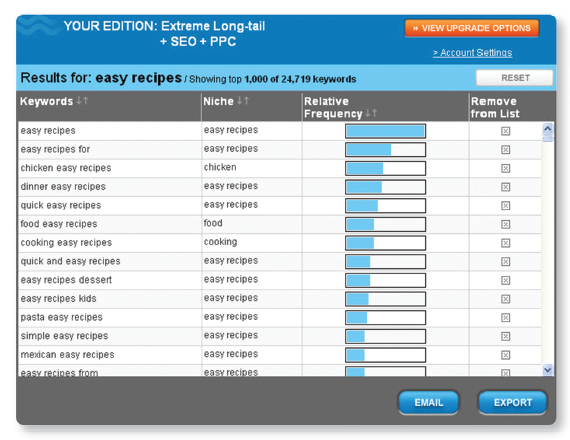Data-Driven Blogging and the Advantage of Editorial Calendars

Maintaining a corporate blog has many business benefits; both for search engine optimization (SEO) and from a lead generation perspective:
- Publishing regular new content signals "freshness" and keeps search engines crawling your site on a regular basis.
- Blogging is a great way to rank for long-tail search queries and more informational queries for which sales pages are unlikely to rank; these queries often reveal a high degree of intent.
- Blogging fosters link-building, because helpful, informative blog posts are more likely to attract natural editorial links than sales pages.
- Positioning yourself as an expert in your field builds industry authority, trust and the strength of your brand.
For these reasons and more, many companies have launched corporate blogs. The most successful of them have large returning readerships (in addition to high rankings) because they're good at anticipating what their audience wants to read.
The best way to answer the question - what does your audience want? - is to use all the data at your disposal to define your blog's content and editorial calendar. This article will outline a three-step strategy for using tools and analytics to build a steady stream of content that will appeal to your readers and customers and help achieve high search engine rankings.
Step 1: Generating Content Ideas from Keyword Research
When launching a new blog with a topical focus, it's a good idea to use keyword research tools to help create a framework of topics to cover. This foundational content will serve to establish your blog as an authoritative source of information in the industry and on the chosen topic. For example: You own a kitchen supply company and have decided to launch a food blog. By researching food-related keywords, you can plan some of the basic topics your writers will cover. This can also help define the major categories of your blog.
By researching "recipes," you might notice a large volume of searches for "easy recipes". This can be the focus of the new blog.
Drilling down further into that niche, outline some subcategories to tackle, such as:
- Easy chicken recipes
- Easy pasta recipes
- Easy dessert recipes
- Easy recipes for kids
- Easy Mexican recipes
Using simple keyword research, you have now established a focal point of the blog as well as generated several ideas to get started with and on which to focus optimization efforts. And, based on this research, you now know some of the topics most relevant to your target audience.
Step 2: Using Keyword Referrals to Build Out the Editorial Calendar
Once you've covered the basics on the blog, it's time to start delving into analytics data to find more specific, long-tail keywords that are driving traffic to your website. This data is especially valuable because it's private, personalized, and proprietary. These are real keywords that are bringing real people - customers and prospects - to your pages.
Go into your analytics application and look for referring keywords - the terms that people have entered into search engines that led them to your blog. You should find some interesting long-tail phrases that are relevant to your blog, but perhaps for which you haven't yet created dedicated, targeted posts.
For example:
- How to make guacamole
- Easy recipe for chicken parmesan
- Quick birthday cake recipes
By tackling these phrases in new blog posts, you will capture more traffic in those niches from search engines, as well as provide even more specific, useful and linkready content for your readers.
Step 3: Using Traffic and Engagement Data to Optimize and Refine Your Strategies
Don't stop at using keyword tools and analytics data to inspire new blog posts. You can also use this data to go back and further optimize your existing blog content for search. Published posts are still valuable sources of new traffic, links and leads even when they aren't new. And, you can use your best-performing posts as models for creating new content that will have the most impact with your audience.
Here are some ways to use analytics data to optimize content and refine your direction:
- Check keyword reports for specific blog posts. Are the keywords that are driving traffic the ones that you optimized the page for? Look for missed opportunities. Are there keyword variations you could go back and include in the copy? Is your title tag doing enough work?
- Pay attention to engagement too. Which blog posts have the most comments? Which posts have low bounce rates or high conversion and click-through rates? How can you replicate those conditions?
- Look for patterns in your highest-traffic and best-converting blog posts. Are they how-to posts? Videos? What types of posts get the most links? Do your readers like longer posts or shorter posts? List-style posts or articles? Learn from your own mistakes as well as your own wins. Repeat what works and don't waste time on what doesn't.
If you get into the habit of incorporating data into your content development strategy, you'll find that you have happier, more engaged readers, and more of them.
About the Author: Elisa Gabbert is the Content Development Manager at WordStream Inc., a provider of PPC management software and services and keyword research tools, where she manages the WordStream Internet Marketing Blog, social media activities and other content marketing efforts. You can follow her on Twitter at @egabbert.
ALSO READ: Setting an Editorial Calendar
An editorial calendar is an excellent way to ensure blog posts are timely and relevant. Calendars are also attractive to advertisers. They give them the opportunity to prepare ad materials, as well as offer a long view of upcoming material that might be good fits for future or ongoing ads.











